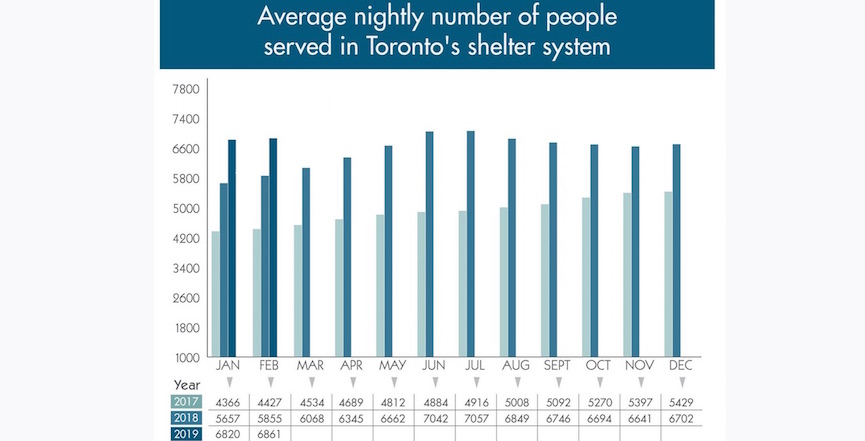This week I read a blog where John Clapp, 54 years old wrote:
“Most of us are here because of a lack of affordable housing or inadequate housing supports. Collectively, we constitute the human fallout of housing insecurity — or to put it another way — the collateral damage of soaring rent rates in a ‘world class city.'”
Front-line workers in Toronto are frustrated, frantic, angry and blunt. Twitter is like a release valve letting it all out.
Toronto street nurse Roxie Danielson posed this question on Twitter:
“Where will people go when the Queen Elizabeth 200 bed respite site closes in April? How will Toronto accommodate for people’s shelter needs in a full shelter system?”
We’re all wondering including the best and brightest in this work.
Greg Cook, a frontline outreach worker who coordinates the monthly Homeless Memorial tweets:
“I know a woman who just tried to get a shelter bed through central intake. Was told everything is full. @JohnTory people have nowhere to go when they want a bed.”
Others echo Greg’s story. A peer support worker tweeted this week that one of her patients, with shelters all full and untenable, stayed in a ditch. Another reports being on the phone all day — there were no beds.
Rafi Aaron from the Interfaith Coalition to Fight Homelessness still writes in the Twitter style of 140 characters:
“When the system is really in trouble you always see it @ central intake & their inability to 2 find ppl beds. System is so fragile when we couldn’t open r OOTC Feb 12 (no heat) the City came up w/42 replacement beds 4 r 60 & none of these could b found @ respites.”
Most senior managers in the city’s shelter division and public health shy away from Twitter but for Brad Ross, it’s part of his job. Known for his superb communication skills while at Toronto Transit Commission, Ross is now Toronto’s chief communication officer and appears to be the messenger for all things homeless and shelter related including the recent eviction of a homeless encampment under the Gardiner Expressway.
In his response to “where will homeless people go (when the respite closes)?” Ross tweeted:
“Other respites will also work to accommodate. As respites, typically, see their highest usage in the winter months, we anticipate an easing of demand for respites with the warmer weather. Will be keeping a close watch, of course.”
Fact: there are approximately 7,000 people in real shelters and an additional 1,000 people sleeping in respites, overnight drop-ins and Out of the Cold sites, all at capacity.
Ross’ tweet became fuel on the fire.
Patricia O’Connell, executive director of Sistering, a day drop-in that now operates overnight to accommodate 50 women per night, some of whom are seniors or disabled, on mats and chairs had a thing or two to say:
“Mr. Ross, demand does not decrease with the warmer weather. Our experience over the past 3 years is exactly the opposite. We have even more women, over capacity, in the warmer months. And we are over capacity 12 months of the year.”
Joyce Rankin, an experienced nurse manager of a homeless health program and who volunteers at an Out of the Cold program also weighed in:
“With respect, you must be joking. I am going to assume this is a joke, otherwise it would demonstrate a lack of knowledge about the need. Our clients need adequate housing year round. Homelessness doesn’t end when the weather gets warmer. There is no such thing as easing of demand.”
Lauro Monteiro, who best knows the needs of senior men added:
“There is no ‘easing of demand.’ Actually the opposite. People are forced out doors. False logic that there is flex to accommodate, not to mention conditions in the flex locations are inhumane.“
A worker from a family shelter:
“Hey @JohnTory. Last night in Toronto children were sleeping in stairwells and on floors b/c families couldn’t access shelter beds.“
A social worker points out the mixed message of suggesting the city expects the normal seasonal “spring camping” to occur when evictions are the result of sleeping outside:
“An ‘easing’ meaning people move outside to then be bulldozed over by your staff? Where do you think people go? Magical affordable *spring* housing eh? #TOpoli“
And Gillian Kolla, a PhD candidate in public health exposes the city’s own truth with their statistics (see graph image):
“Hi @bradrossTO would you mind pointing out where the “easing of demand” happened in this graph (taken directly from the @cityoftoronto website?) Looks like demand last summer stayed really high. One might even say, it was at emergency levels. Thanks!”
Why do I focus on these Twitter comments today? They are the evidence and the witnessing of experts. We have done the deputations, done the meeting with city councillors, petitioned the mayor, proposed solutions such as the Shelter, Housing and Justice Network’s call for 2,000 more shelter beds. We have also called for social housing, forever. The neglect by all levels of government is simply intentional neglect and the end result comparable to what Friedrich Engels in 1845 called “social murder.”
There are next steps and in Toronto we will join the Ontario Coalition Against Poverty to protest both at the Queen Elizabeth respite site and then at Metro Hall, the suite of offices where shelter and housing bureaucrats are housed.
Cathy Crowe is a street nurse, author and filmmaker who works nationally and locally on health and social justice issues. She has fostered numerous coalitions and advocacy initiatives that have achieved significant public policy victories. Visit her website and follow her on Twitter.
Image: City of Toronto website
Help make rabble sustainable. Please consider supporting our work with a monthly donation. Support rabble.ca today for as little as $1 per month!




